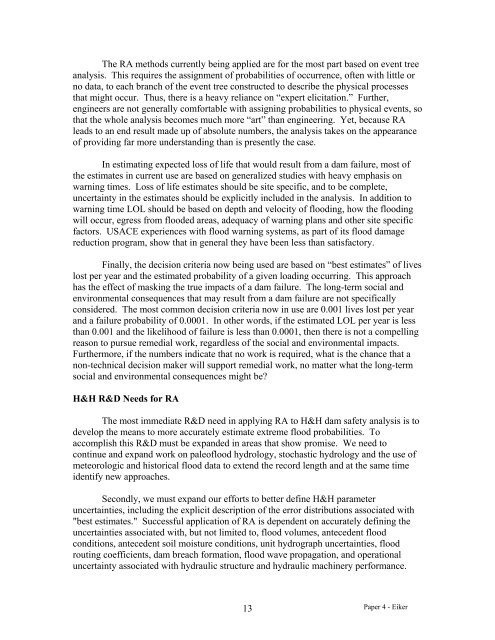Hydrologic Issues for Dams - Association of State Dam Safety Officials
Hydrologic Issues for Dams - Association of State Dam Safety Officials
Hydrologic Issues for Dams - Association of State Dam Safety Officials
You also want an ePaper? Increase the reach of your titles
YUMPU automatically turns print PDFs into web optimized ePapers that Google loves.
The RA methods currently being applied are <strong>for</strong> the most part based on event treeanalysis. This requires the assignment <strong>of</strong> probabilities <strong>of</strong> occurrence, <strong>of</strong>ten with little orno data, to each branch <strong>of</strong> the event tree constructed to describe the physical processesthat might occur. Thus, there is a heavy reliance on “expert elicitation.” Further,engineers are not generally com<strong>for</strong>table with assigning probabilities to physical events, sothat the whole analysis becomes much more “art” than engineering. Yet, because RAleads to an end result made up <strong>of</strong> absolute numbers, the analysis takes on the appearance<strong>of</strong> providing far more understanding than is presently the case.In estimating expected loss <strong>of</strong> life that would result from a dam failure, most <strong>of</strong>the estimates in current use are based on generalized studies with heavy emphasis onwarning times. Loss <strong>of</strong> life estimates should be site specific, and to be complete,uncertainty in the estimates should be explicitly included in the analysis. In addition towarning time LOL should be based on depth and velocity <strong>of</strong> flooding, how the floodingwill occur, egress from flooded areas, adequacy <strong>of</strong> warning plans and other site specificfactors. USACE experiences with flood warning systems, as part <strong>of</strong> its flood damagereduction program, show that in general they have been less than satisfactory.Finally, the decision criteria now being used are based on “best estimates” <strong>of</strong> liveslost per year and the estimated probability <strong>of</strong> a given loading occurring. This approachhas the effect <strong>of</strong> masking the true impacts <strong>of</strong> a dam failure. The long-term social andenvironmental consequences that may result from a dam failure are not specificallyconsidered. The most common decision criteria now in use are 0.001 lives lost per yearand a failure probability <strong>of</strong> 0.0001. In other words, if the estimated LOL per year is lessthan 0.001 and the likelihood <strong>of</strong> failure is less than 0.0001, then there is not a compellingreason to pursue remedial work, regardless <strong>of</strong> the social and environmental impacts.Furthermore, if the numbers indicate that no work is required, what is the chance that anon-technical decision maker will support remedial work, no matter what the long-termsocial and environmental consequences might be?H&H R&D Needs <strong>for</strong> RAThe most immediate R&D need in applying RA to H&H dam safety analysis is todevelop the means to more accurately estimate extreme flood probabilities. Toaccomplish this R&D must be expanded in areas that show promise. We need tocontinue and expand work on pale<strong>of</strong>lood hydrology, stochastic hydrology and the use <strong>of</strong>meteorologic and historical flood data to extend the record length and at the same timeidentify new approaches.Secondly, we must expand our ef<strong>for</strong>ts to better define H&H parameteruncertainties, including the explicit description <strong>of</strong> the error distributions associated with"best estimates." Successful application <strong>of</strong> RA is dependent on accurately defining theuncertainties associated with, but not limited to, flood volumes, antecedent floodconditions, antecedent soil moisture conditions, unit hydrograph uncertainties, floodrouting coefficients, dam breach <strong>for</strong>mation, flood wave propagation, and operationaluncertainty associated with hydraulic structure and hydraulic machinery per<strong>for</strong>mance.13Paper 4 - Eiker

















